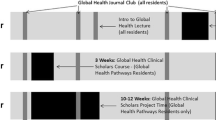Abstract
Background
The lack of appropriate numbers of anesthesia and surgical care providers in many resource-poor countries around the world, especially in rural populations, prevents adequate care of the large numbers of patients who require surgery in these settings.
Methods
This article provides a 10-year review of a rural hospital located in East Africa which developed a training program based on parallel training of anesthesia and surgical care providers. We report the process of building the foundational aspects of a customized medical education program that addresses specific concerns related to the work in a rural African context, which may be very different from medical care provided in the urban settings of low income countries (LIC). We analyzed how the parallel training can provide the clinical tools needed to have a practical impact on the surgical burden in rural Africa.
Results
The parallel training program combining training of nurse-anesthetists with the training of multiple levels of surgical care providers, from interns to fellows, led to a fourfold increase in the number of surgical cases. Surgical subspecialty training and the development of an anesthesia care team with anesthesia consultant(s) oversight can serve to maintain a high level of complex and expanding surgical case volume in a rural African hospital setting.
Conclusions
This model can be applied to other similar situations in LIC, where the anesthesia and surgical care can be coupled and then customized for the unique clinical rural setting.


Similar content being viewed by others
References
Weiser TG, Regenbogen SE, Thompson KD et al (2008) An estimation of the global volume surgery: a modeling strategy based upon available data. Lancet 372:139–144
Hodges SC, Mijumbi C, Okello M et al (2007) Anaesthesia in developing countries: defining the problems. Anaesthesia 62:4–11
Walker IA, Morton NS (2009) Pediatric healthcare: the role of anesthesia and critical care services in the developing world. Pediatr Anesth 19:1–4
Magoha GA, Ngumi ZW (1999) Training of surgeons in Kenya at the University of Nairobi teaching hospital. East Afr Med J 76:462–464
Greene NM (1991) Anesthesia in underdeveloped countries: a teaching program. Yale J Biol Med 64:403–407
Lokossou T, Zoumenou E, Secka G et al (2007) Anesthesia in French-speaking sub-Saharan Africa: an overview. Acta Anaesthesiol Belg 58:197–209
Akinyemi OO, Soyannwo AO (1980) The choice of anaesthesia as a career by undergraduates in a developing country. Anaesthesia 35:712–715
Dobson MB (2000) Distance learning—an educational tool for developing countries. Anaesthesiol Reahim 25:164–166
Ozgediz D, Galukande M, Mabweijano J et al (2008) The neglect of the global surgical workforce: experience and evidence from Uganda. World J Surg 32:1208–1215
Lavy CB, Mannion SJ, Mkandawire NC et al (2007) Club foot treatment in Malawi—a public health approach. Disabil Rehabil 29:857–862
Wasunna AE (1987) Surgical manpower in Africa. Bull Am Coll Surg 72:18–19
Dent DM (2008) Surgery in developing countries: lessons from Uganda. World J Surg 32:1216–1217
Hadley GP, Mars M (2008) Postgraduate medical education in paediatric surgery: videoconferencing—a possible solution for Africa. Pediatr Surg Int 24:223–226
Watters DAK, Bayley AC (1987) Training doctors and surgeons to meet the surgical needs of Africa. Br Med J 295:761–763
Ameh EA, Adejuyigbe O, Nmadu PT (2006) Pediatric surgery in Nigeria. J Pediatr Surg 41:542–546
Mullan F, Frehywot S (2007) Non-physician clinicians in 47 sub-Saharan African countries. Lancet 370:2158–2163
Miles SH, Ololo H (2003) Traditional surgeons in sub-Saharan Africa: images from South Sudan. Int J STD AIDS 14:505–508
Walker IA, Wilson IH (2008) Anaesthesia in developing countries—a risk for patients. Lancet 371:968–969
McKenzie AG (1998) Operative obstetric mortality at Harare Central Hospital 1992–94: an anaesthetic view. Int J Obstet Anesth 7:237–241
Ekanem AD, Udoma EJ, Etuk SJ et al (2008) Outcome of emergency caesarean sections in Calabar, Nigeria: impact of the seniority of the medical team. J Obstet Gynaecol 28:198–201
World Health Organization (2009) Health inequities: table 8. World Health Statistics 2009, pp 119–129
Shively EH, Shively SA (2005) Threats to rural surgery. Am J Surg 190:200–205
Walker IA, Morton NS (2009) Pediatric healthcare—the role for anesthesia and critical care services in the developing world. Pediatr Anesth 19:1–4
Wilson IH (2009) Con: anaesthesia for children in the developing world should be delivered by medical anesthetists. Pediatr Anesth 19:39–41
Soyannwo OA, Elegbe EO (1999) Anaesthetic manpower development in West Africa. Afr J Med Sci 28:163–165
Nordberg E, Holmberg S, Kiugu S (1996) Rates of major surgery by age and sex in a rural district hospital. Ann Trop Med Parasitol 90:213–221
Gosselin RA, Spiegel DA, Coughlin R et al (2009) Injuries: the neglected burden in developing countries. Bull WHO 87:246
Bosenberg AT (2007) Pediatric anesthesia in developing countries. Curr Opin Anaesthesiol 20:204–210
Khan KS, Wojkyla D, Say L et al (2006) WHO analysis of causes of maternal death: a systemic review. Lancet 367:1066–1074
O’Hare BA, Nakakeeto M, Southall DP (2006) A pilot study to determine if nurses trained in basic neonatal resuscitation would impact the outcome of neonates delivered in Kampala, Uganda. J Trop Pediatr 52:376–379
Black RE, Morris SS, Bryce J (2003) Where and why are 10 million children dying every year? Lancet 361:26–34
Ellis M, Costello A (1997) Birth asphyxia, apgar score and neonatal encephalopathy. Indian Pediatr 34:1178–11975
Costello A, White H (2001) Reducing global inequalities in child health. Arch Dis Child 84:98–102
Gosselin RA, Heitto M (2008) Cost-effectiveness of a district trauma hospital in Battambang, Cambodia. World J Surg 32:2450–2453
World Health Organization (2009) Health workforce, infrastructure, essential medicines: table 6. World Health Statistics 2009, pp 95–105
Author information
Authors and Affiliations
Corresponding author
Rights and permissions
About this article
Cite this article
Newton, M., Bird, P. Impact of Parallel Anesthesia and Surgical Provider Training in Sub-Saharan Africa: A Model for a Resource-poor Setting. World J Surg 34, 445–452 (2010). https://doi.org/10.1007/s00268-009-0195-z
Published:
Issue Date:
DOI: https://doi.org/10.1007/s00268-009-0195-z




